Input interpretation

HCl hydrogen chloride + NaH sodium hydride ⟶ H_2 hydrogen + NaCl sodium chloride
Balanced equation
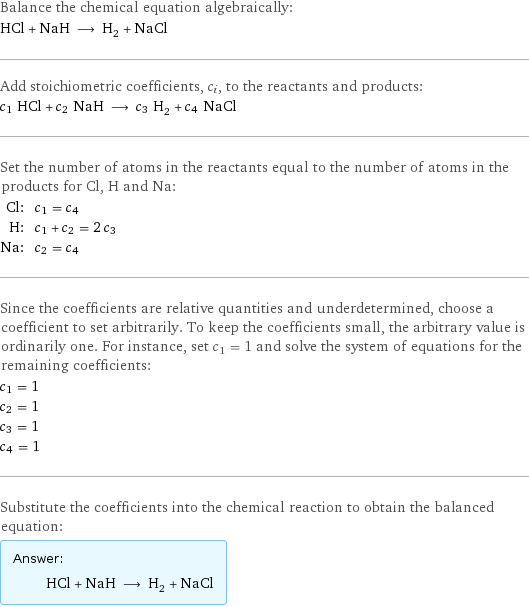
Balance the chemical equation algebraically: HCl + NaH ⟶ H_2 + NaCl Add stoichiometric coefficients, c_i, to the reactants and products: c_1 HCl + c_2 NaH ⟶ c_3 H_2 + c_4 NaCl Set the number of atoms in the reactants equal to the number of atoms in the products for Cl, H and Na: Cl: | c_1 = c_4 H: | c_1 + c_2 = 2 c_3 Na: | c_2 = c_4 Since the coefficients are relative quantities and underdetermined, choose a coefficient to set arbitrarily. To keep the coefficients small, the arbitrary value is ordinarily one. For instance, set c_1 = 1 and solve the system of equations for the remaining coefficients: c_1 = 1 c_2 = 1 c_3 = 1 c_4 = 1 Substitute the coefficients into the chemical reaction to obtain the balanced equation: Answer: | | HCl + NaH ⟶ H_2 + NaCl
Structures

+ ⟶ +
Names

hydrogen chloride + sodium hydride ⟶ hydrogen + sodium chloride
Reaction thermodynamics
Enthalpy
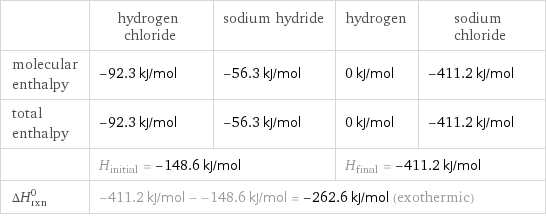
| hydrogen chloride | sodium hydride | hydrogen | sodium chloride molecular enthalpy | -92.3 kJ/mol | -56.3 kJ/mol | 0 kJ/mol | -411.2 kJ/mol total enthalpy | -92.3 kJ/mol | -56.3 kJ/mol | 0 kJ/mol | -411.2 kJ/mol | H_initial = -148.6 kJ/mol | | H_final = -411.2 kJ/mol | ΔH_rxn^0 | -411.2 kJ/mol - -148.6 kJ/mol = -262.6 kJ/mol (exothermic) | | |
Gibbs free energy
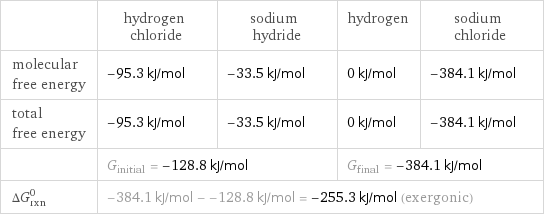
| hydrogen chloride | sodium hydride | hydrogen | sodium chloride molecular free energy | -95.3 kJ/mol | -33.5 kJ/mol | 0 kJ/mol | -384.1 kJ/mol total free energy | -95.3 kJ/mol | -33.5 kJ/mol | 0 kJ/mol | -384.1 kJ/mol | G_initial = -128.8 kJ/mol | | G_final = -384.1 kJ/mol | ΔG_rxn^0 | -384.1 kJ/mol - -128.8 kJ/mol = -255.3 kJ/mol (exergonic) | | |
Entropy
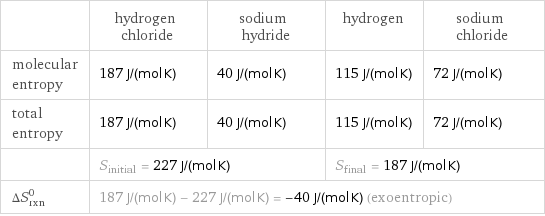
| hydrogen chloride | sodium hydride | hydrogen | sodium chloride molecular entropy | 187 J/(mol K) | 40 J/(mol K) | 115 J/(mol K) | 72 J/(mol K) total entropy | 187 J/(mol K) | 40 J/(mol K) | 115 J/(mol K) | 72 J/(mol K) | S_initial = 227 J/(mol K) | | S_final = 187 J/(mol K) | ΔS_rxn^0 | 187 J/(mol K) - 227 J/(mol K) = -40 J/(mol K) (exoentropic) | | |
Equilibrium constant
![Construct the equilibrium constant, K, expression for: HCl + NaH ⟶ H_2 + NaCl Plan: • Balance the chemical equation. • Determine the stoichiometric numbers. • Assemble the activity expression for each chemical species. • Use the activity expressions to build the equilibrium constant expression. Write the balanced chemical equation: HCl + NaH ⟶ H_2 + NaCl Assign stoichiometric numbers, ν_i, using the stoichiometric coefficients, c_i, from the balanced chemical equation in the following manner: ν_i = -c_i for reactants and ν_i = c_i for products: chemical species | c_i | ν_i HCl | 1 | -1 NaH | 1 | -1 H_2 | 1 | 1 NaCl | 1 | 1 Assemble the activity expressions accounting for the state of matter and ν_i: chemical species | c_i | ν_i | activity expression HCl | 1 | -1 | ([HCl])^(-1) NaH | 1 | -1 | ([NaH])^(-1) H_2 | 1 | 1 | [H2] NaCl | 1 | 1 | [NaCl] The equilibrium constant symbol in the concentration basis is: K_c Mulitply the activity expressions to arrive at the K_c expression: Answer: | | K_c = ([HCl])^(-1) ([NaH])^(-1) [H2] [NaCl] = ([H2] [NaCl])/([HCl] [NaH])](../image_source/7176197c016a042226e44e02e285df27.png)
Construct the equilibrium constant, K, expression for: HCl + NaH ⟶ H_2 + NaCl Plan: • Balance the chemical equation. • Determine the stoichiometric numbers. • Assemble the activity expression for each chemical species. • Use the activity expressions to build the equilibrium constant expression. Write the balanced chemical equation: HCl + NaH ⟶ H_2 + NaCl Assign stoichiometric numbers, ν_i, using the stoichiometric coefficients, c_i, from the balanced chemical equation in the following manner: ν_i = -c_i for reactants and ν_i = c_i for products: chemical species | c_i | ν_i HCl | 1 | -1 NaH | 1 | -1 H_2 | 1 | 1 NaCl | 1 | 1 Assemble the activity expressions accounting for the state of matter and ν_i: chemical species | c_i | ν_i | activity expression HCl | 1 | -1 | ([HCl])^(-1) NaH | 1 | -1 | ([NaH])^(-1) H_2 | 1 | 1 | [H2] NaCl | 1 | 1 | [NaCl] The equilibrium constant symbol in the concentration basis is: K_c Mulitply the activity expressions to arrive at the K_c expression: Answer: | | K_c = ([HCl])^(-1) ([NaH])^(-1) [H2] [NaCl] = ([H2] [NaCl])/([HCl] [NaH])
Rate of reaction
![Construct the rate of reaction expression for: HCl + NaH ⟶ H_2 + NaCl Plan: • Balance the chemical equation. • Determine the stoichiometric numbers. • Assemble the rate term for each chemical species. • Write the rate of reaction expression. Write the balanced chemical equation: HCl + NaH ⟶ H_2 + NaCl Assign stoichiometric numbers, ν_i, using the stoichiometric coefficients, c_i, from the balanced chemical equation in the following manner: ν_i = -c_i for reactants and ν_i = c_i for products: chemical species | c_i | ν_i HCl | 1 | -1 NaH | 1 | -1 H_2 | 1 | 1 NaCl | 1 | 1 The rate term for each chemical species, B_i, is 1/ν_i(Δ[B_i])/(Δt) where [B_i] is the amount concentration and t is time: chemical species | c_i | ν_i | rate term HCl | 1 | -1 | -(Δ[HCl])/(Δt) NaH | 1 | -1 | -(Δ[NaH])/(Δt) H_2 | 1 | 1 | (Δ[H2])/(Δt) NaCl | 1 | 1 | (Δ[NaCl])/(Δt) (for infinitesimal rate of change, replace Δ with d) Set the rate terms equal to each other to arrive at the rate expression: Answer: | | rate = -(Δ[HCl])/(Δt) = -(Δ[NaH])/(Δt) = (Δ[H2])/(Δt) = (Δ[NaCl])/(Δt) (assuming constant volume and no accumulation of intermediates or side products)](../image_source/4592989eb93ae51590591320874ea56f.png)
Construct the rate of reaction expression for: HCl + NaH ⟶ H_2 + NaCl Plan: • Balance the chemical equation. • Determine the stoichiometric numbers. • Assemble the rate term for each chemical species. • Write the rate of reaction expression. Write the balanced chemical equation: HCl + NaH ⟶ H_2 + NaCl Assign stoichiometric numbers, ν_i, using the stoichiometric coefficients, c_i, from the balanced chemical equation in the following manner: ν_i = -c_i for reactants and ν_i = c_i for products: chemical species | c_i | ν_i HCl | 1 | -1 NaH | 1 | -1 H_2 | 1 | 1 NaCl | 1 | 1 The rate term for each chemical species, B_i, is 1/ν_i(Δ[B_i])/(Δt) where [B_i] is the amount concentration and t is time: chemical species | c_i | ν_i | rate term HCl | 1 | -1 | -(Δ[HCl])/(Δt) NaH | 1 | -1 | -(Δ[NaH])/(Δt) H_2 | 1 | 1 | (Δ[H2])/(Δt) NaCl | 1 | 1 | (Δ[NaCl])/(Δt) (for infinitesimal rate of change, replace Δ with d) Set the rate terms equal to each other to arrive at the rate expression: Answer: | | rate = -(Δ[HCl])/(Δt) = -(Δ[NaH])/(Δt) = (Δ[H2])/(Δt) = (Δ[NaCl])/(Δt) (assuming constant volume and no accumulation of intermediates or side products)
Chemical names and formulas
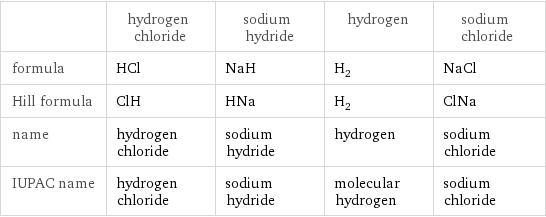
| hydrogen chloride | sodium hydride | hydrogen | sodium chloride formula | HCl | NaH | H_2 | NaCl Hill formula | ClH | HNa | H_2 | ClNa name | hydrogen chloride | sodium hydride | hydrogen | sodium chloride IUPAC name | hydrogen chloride | sodium hydride | molecular hydrogen | sodium chloride
Substance properties
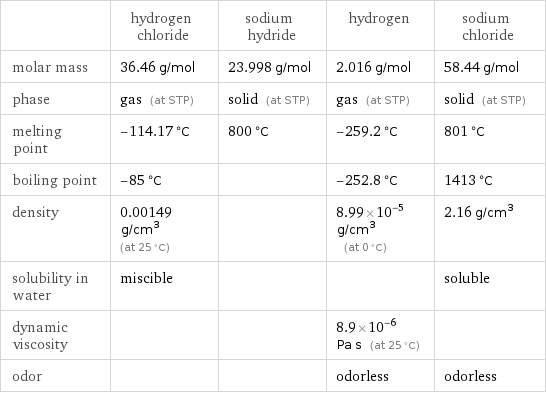
| hydrogen chloride | sodium hydride | hydrogen | sodium chloride molar mass | 36.46 g/mol | 23.998 g/mol | 2.016 g/mol | 58.44 g/mol phase | gas (at STP) | solid (at STP) | gas (at STP) | solid (at STP) melting point | -114.17 °C | 800 °C | -259.2 °C | 801 °C boiling point | -85 °C | | -252.8 °C | 1413 °C density | 0.00149 g/cm^3 (at 25 °C) | | 8.99×10^-5 g/cm^3 (at 0 °C) | 2.16 g/cm^3 solubility in water | miscible | | | soluble dynamic viscosity | | | 8.9×10^-6 Pa s (at 25 °C) | odor | | | odorless | odorless
Units
